
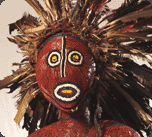 |
|
| The Bandjoun museum | |
| Permanent exhibition | |
| Information | |
The land and the men
The land
| Bandjoun lies in the province of West Cameroon and covers more than three-quarters of the department of Koung-khi. It occupies two different sectors. The first is a low-lying area (900 to 1100m above sea-level), not very large and almost empty, which is bordered for almost 28 km by the river Noun. The area is for both hunting and farming. The second and larger sector is the high plateau (1500m above sea-level) dominating a drop in altitude of between 300 and 500 m of the valley of the Noun. It has rounded hills between which streams have eroded a network of valleys, often marshy where the raffia-palms that are so very useful for building, food and making objects, grow abundantly. | 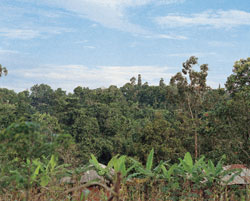 |
|
A Bandjoun landscape |
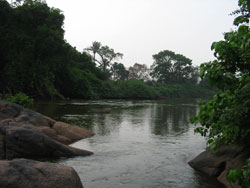 |
The climate is tropical with two seasons (one rainy, the other dry). |
|
| The river Noun |
The men
| The kingdom of Bandjoun ( gung a djo), capital of art and the main cultural centre of the Bamiléké plateau, has more than 150,000 inhabitants (including the diaspora) in a surface area of 264 km². It is one of the few hundred territorial and political independent monarchies, of varying sizes, that were progressively formed over some six centuries in the region of the volcanic plateaux of the western part of Cameroon called Grassland (or Grassfield). | 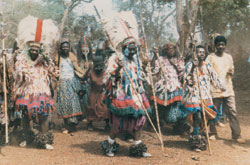 |
|
Ceremony in Bandjoun |
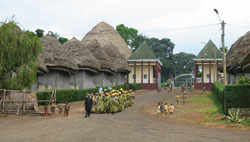 |
The Bandjoun language is ghomala' which belongs to central Bamiléké central, a subdivision of the Eastern Grassfield, one of the Bantu languages of western Cameroon. The contemporary languages are on fact only the result of a long local diversification, resulting in thousands of years, in a single basic language, dating back at least 5,000 years, of an autochthonous population, the proto-Bantu. |
|
A group of women go down to the royal residence |
|
|
[ Top page ]
| Home | The four museums | The project | Baham museum | Bandjoun museum | Mankon museum | Babungo museum |
| bandjoun@museumcam.org | Copyright 2005 C.O.E. | Powered by SYNUS |




